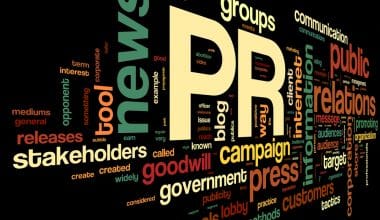The difference between public relations vs media relations can be confusing. Public relations and media are two aspects of a company’s approach to advertising its products and brand objective. Although the two publicity strategies can overlap in certain ways, there are also significant differences between public relations vs media.
Furthermore, businesses may have detailed public relations plans that they use regularly to reach customers, whereas media relations may account for only a small portion of an overall public relations strategy. In this post, I will define media relations and explain the differences between media vs. public relations so that you can implement the most effective tactics for your firm.
Key Takeaways
- Media relations and public relations serve different purposes within an organization. Media relations focuses on managing interactions with journalists and securing media coverage to benefit the organization. In contrast, public relations is a broader field that encompasses various strategies to build and maintain a positive image of the organization, including community relations, crisis management, and internal communications.
- Media relations is a tactical, precise function within the broader public relations strategy, involving activities such as pitching stories and coordinating interviews. Public relations involves a comprehensive approach that includes media relations but also extends to strategic planning and managing public perceptions across multiple channels.
- The primary purpose of media relations is to disseminate information about a brand to a broad audience through the media. Public relations aims to create a positive image and build trust with various publics, including customers, employees, investors, and the community.
- Both PR and media relations offer distinct benefits. PR helps attract new customers, build trust, and promote a positive brand image. Media relations, on the other hand, boosts credibility through media exposure, build partnerships with journalists, and grants control over how the media portrays your brand.
- While distinct, PR and media relations work best when integrated. You need a clear communication strategy aligned with your goals, followed by identifying target audiences, crafting compelling content, and building media relationships to amplify your message.
Public Relations Vs Media Relations
I would like to talk about the difference between both strategies, but first, let’s define both terms:
What is Media Relations?
Media relations is the art of managing relationships with journalists, editors, and other members of the media. The goal is to get your story told in a way that benefits your organization. Think of it as the bridge between your brand and the media.
In simpler terms, media relations is about pitching stories, coordinating interviews, and responding to media inquiries. It’s a highly tactical role, requiring precision and excellent communication skills. According to a 2021 survey by Cision, 73% of journalists prefer being pitched via email, showcasing how digital our interactions have become.
A few years back, I was working with a tech startup that was about to launch an app. Our goal was to secure coverage in major tech publications. I remember the countless hours spent crafting the perfect pitch and the numerous follow-ups. We eventually landed a feature in one of the tech publications. The payoff was a massive surge in downloads and investor interest. That’s the power of media relations in action.
In media relations, it’s all about strategy. You need to know the right journalist for your story, understand their beat, and tailor your pitch accordingly. The Public Relations Society of America (PRSA) emphasizes the importance of understanding media needs and maintaining a mutually beneficial relationship.
What is Public Relations?
Public relations (PR) is the broader umbrella under which media relations falls. PR encompasses all forms of communication that build and maintain a positive image of an organization in the public eye. This includes media relations, but also community relations, internal communications, crisis management, and more.
According to the Global Communications Report by USC Annenberg, 60% of PR professionals believe that the industry will be more important to their organizations in the next five years, highlighting the growing significance of PR.
I remember we once faced a crisis when a high-profile event didn’t go as planned. Managing this required more than just media relations. We needed to address stakeholders, communicate with volunteers, and manage our online reputation. This holistic approach was crucial in maintaining our organization’s credibility and support.
PR is about the big picture. It involves creating a cohesive strategy that aligns with the organization’s goals and values. This includes managing public perceptions, engaging with the community, and ensuring consistent messaging across all channels. The Institute for Public Relations (IPR) stresses the importance of strategic planning and ethical practices in PR.
Now that we know the meaning of both strategies, let’s talk about what makes them different between both methods in the next section below.
Differences Between Media Vs Public Relations
Even though the media can be part of a bigger public relations plan, there are some important differences between the two sectors, such as:
#1. Purpose
One of the most important differences between public relations vs media relations is the purpose businesses use them for. Businesses and organizations typically rely on media relations for a single purpose: to disseminate information about a brand to a broad audience.
However, public relations comprises various processes, including media relations, that aim to tell a brand’s story and create a positive image for public audiences. Companies use media relations to communicate vital messages to the general public, whereas public relations is primarily concerned with increasing brand awareness and reputation.
#2. Publicizing
Public relations is all about promoting a company’s value. PR professionals adopt strategies that help companies connect with target audiences, establish trust with customer markets, and attract customers to their offers. However, media relations is one strategy that PR professionals can use in a public relations and marketing plan to raise awareness of a brand’s offerings, mission, and story. Businesses use public relations strategies to outline how they intend to reach target audiences, and media relations is one such technique that a company can use to help publicize its offerings and value proposition.
#3. Strategies
PR and media relations use various strategies. Public relations is essentially a set of strategies that firms use to communicate with customers and develop trust in their markets. As a result, public relations might include various strategies for achieving this purpose. However, media relations is a distinct method that public relations professionals frequently use to increase their organization’s visibility.
#4. Implementation
Businesses can use various public relations strategies to advance their purpose and business goals. To achieve business goals, public relations specialists may use press releases, social media alerts, or local events. As a result, a company may only use media relations if it needs to communicate a vital message through news and other media channels. Furthermore, many organizations adopt PR plans constantly, which may or may not involve a media relations strategy.
Benefits of Media Vs Public Relations
Benefits of Public Relations
Public relations can provide numerous benefits to organizations that employ effective PR strategies. Successful public relations strategies, for example, can help a company acquire new audiences and build trust with its customers. Several other benefits of incorporating public relations strategies into a marketing plan include:
#1. Attracts target customers
One of the most significant benefits of a successful PR strategy is the capacity to attract new clients in your target areas. Diverse public relations methods can help businesses expand their market reach and approach new clients. PR also helps customers learn about a brand’s goal, which leads to increased trust in the brand’s services.
#2. Publicizes value propositions
PR is a great way to get your value proposition in front of the right people. Public relations employs strategies such as digital marketing and press releases to communicate a brand’s message to its target audience. While media relations is one strategy that PR professionals can employ to publicize a brand’s value proposition, public relations can take many different approaches to promoting what a company offers its customers.
#3. Generates prospective leads
When you can expose the value of your brand and reach out to your target audience, your organization’s chances of generating leads increase dramatically. PR techniques work to reach potential clients who may have never heard of your company before, making it an effective strategy for generating new leads.
#4. Promotes a positive brand image
Public relations is essentially the approach that firms use to establish a positive reputation in their target markets. Community events and networking with influencers are examples of public relations methods that can help firms and organizations build trust and a positive image with their customers. PR assists firms in maintaining a positive public image, which in turn helps them retain excellent customer relationships.
Benefits of Media Relations
Public relations also includes media relations, therefore media is another helpful strategy for businesses looking to reach out to the public. Successful media relations can benefit businesses and organizations in various ways, including:
#1. Boosts credibility
Businesses can boost their trust and credibility by developing good ties with the media and news channels. When prominent news outlets cover breaking stories about a company or brand, successful media relations focus on building a company’s authority in its industry. With a higher level of authority and credibility, more audiences are likely to follow the brand.
#2. Builds solid partnerships
Businesses that focus on developing good media relations frequently have close relationships with news reporters, journalists, and editors from print and online papers and magazines. Having a strong and favorable relationship with major news sites and media channels can help businesses reach their target audiences faster and ensure the authenticity of their narrative.
#3. Validates with third parties
Companies may benefit from third-party validation. When customers perceive that other parties, entities, and brands support your company, they are more likely to believe in your offers and unique proposal. This validation can help firms build authority in their sector and establish themselves as expert providers of the products or services they offer to clients.
#4. Provides control
Successful media relations also allow businesses control over what the media broadcasts to their audiences. Businesses that have positive relationships with journalists and news reporters can often influence how the media portrays their stories, conveys important messages about their brands, and connects with their target audiences. This control over how the media portrays a company can help firms retain a positive reputation with their target customers.
Why Do You Need Both Public Relations Vs Media Relations?
PR and media relations are both beneficial to your organization, but they serve different functions. PR assists you in establishing and maintaining your reputation with all of your stakeholders. Also, PR enables you to communicate your values, goals, and accomplishments. PR can help you develop trust and loyalty with your customers, employees, investors, and community.
Media relations allow you to amp up your PR statements and reach a wider audience. Media relations enable you to get exposure, credibility, and visibility in the media. Furthermore, Media relations can assist you acquire new customers, partners, investors, and supporters.
How can you Balance PR and Media Relations?
To balance PR and media relations, you must have a clear and consistent approach that aligns with your business goals. You need to determine your target audiences, important messages, and desired outcomes. You must investigate and analyze the media landscape to choose the best channels and sources for your story. Also, you must generate and share interesting, relevant content that shows your value proposition. Monitor and evaluate the impact and efficiency of your public relations and media relations operations.
Is PR the same as media?
No, PR is not the same as media. While they are both involved in communication, they serve different purposes and have distinct roles. Imagine a river (media) carrying information to the ocean (public). PR are professionals navigating the river, strategically placing their messages (boats) in the current to reach specific destinations (target audiences) within the vast ocean.
What do media relations do?
In the communication world, media relations act like a bridge between your organization and the media landscape. It’s all about fostering relationships with journalists, bloggers, influencers, and other media outlets to secure positive placements for your brand. By effectively building relationships with the media, media relations professionals play a crucial role in amplifying a brand’s message, shaping public perception, and ultimately driving business success.
What is an example of media relations?
Imagine you work for a company called “The Bakery,” a local bakery known for its delicious and innovative pastries. The Bakery is launching a new line of vegan and gluten-free treats, catering to a growing audience with dietary restrictions.
Here’s how media relations might play out in this scenario:
- Identifying the Story Angle: The media relations specialist recognizes the rise in popularity of vegan and gluten-free options. They see an opportunity to position The Bakery as a leader in catering to these dietary needs.
- Crafting a Newsworthy Pitch: The specialist develops a compelling pitch highlighting The Bakery’s commitment to inclusivity and deliciousness. The pitch might mention the unique flavor combinations and high-quality ingredients used in the new treat line.
- Targeting the Right Media: Instead of blasting out a generic press release, the specialist identifies relevant media outlets. This could include local food blogs, publications focused on healthy living, or websites catering to vegan and gluten-free audiences.
- Building Relationships and Pitching: The specialist leverages existing relationships with journalists or bloggers who might be interested in the story. They craft a personalized email highlighting the new product line and its potential appeal to the journalist’s audience.
- Securing Media Coverage: Through clear communication and a well-crafted pitch, the specialist secures a feature article on a popular food blog. The article highlights The Bakery’s innovative approach and includes mouthwatering photos of the new treats.
- Measuring Success: The media relations specialist tracks the reach of the article, gauging website traffic and social media engagement. The positive media coverage leads to increased awareness of The Bakery’s new product line, attracting new customers and boosting sales.
This is just one example, but it demonstrates how media relations can be used strategically to generate positive media attention and achieve specific communication goals.
Conclusion
While media relations vs public relations are distinct disciplines, they are interdependent. Media relations are a crucial component of the broader PR strategy. It involves building and maintaining relationships with the media to ensure your stories are told accurately and favorably. PR, on the other hand, encompasses all aspects of managing an organization’s image and relationships with its various publics.
Both require a strategic approach, excellent communication skills, and a deep understanding of the media landscape. By integrating media relations into your broader PR strategy, you can ensure a cohesive and effective approach to managing your organization’s reputation.
Now, I’d love to hear from you. Have you experienced the interplay between media relations vs public relations in your career? How did you manage the different aspects? Share your stories in the comments section!
Related Articles
- WHAT IS MEDIA ANALYSIS: Definitions, Techniques, and Personal Insights
- How to Contact News Media with a Story: A Guide to Getting Your Story Covered by News Outlets
- The Role and Importance of Social Media in Public Relations
- 9 Brilliant Media Kit Hacks & All You Need to Know
- Media Pitch vs. Press Release: How I Differentiate Them.






